News
JF-17B Light Fighter Pitched to Revolutionise China’s Advanced Trainer Fleet – Reports
The prominent display of a JF-17B twin seat lightweight fighter at the Changchun Air Show has been accompanied by reports that efforts are currently being made to market the aircraft to the Chinese People’s Liberation Army Air Force. The JF-17 is one of six fighter types currently in serial production in China, and is the only one that has not been ordered by the Defence Ministry, with the aircraft having been developed for export and ordered in particularly larger numbers for the Pakistan Air Force. As by far the lightest Chinese fighter class, the aircraft has a much more limited combat capability and relies on a much weaker engine and smaller radar than types in production, but remains attractive due to its very low lifetime costs and maintenance needs. While the aircraft is not expected to gain domestic interest for frontline use, unless produced under wartime circumstances as a ‘mobilisation model’ for new squadrons, the possibility remains that the JF-17B twin seat trainer variant could gain interest from the People’s Liberation Army.

A number of features could lead the JF-17B to be favoured as a trainer. The aircraft retains an in flight refuelling capability which other trainers lack, allowing it to cover longer distances in a secondary combat role, and to provide pilots with experience in aerial refuelling as the country’s YY-20 tanker fleet rapidly expands. The aircraft is also reported to have engine commonality with the new J-35 fifth generation fighter, as reports indicate that it has integrated the new WS-21 engine. The JF-17 also has a much more robust combat capability than other trainers, with its combination of an AESA radar and PL-10 and PL-15 air-to-air missiles making it arguably the world’s most capable aircraft of its size for air-to-air combat. Although training units in the People’s Liberation Army Air Force are already relied on for a secondary combat role, the limitations of current trainer aircraft restrict their ability to seriously contribute to the defence of the Chinese mainland even as a lower tier line of defence, with the adoption of the JF-17B potentially being revolutionary in this regard. A significant uncertainty remains as to how the procurement and sustainment costs of the JF-17B may differ compared to those of trainers that have previously been procured, namely the JL-9 and JL-10.












